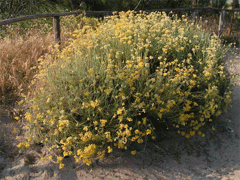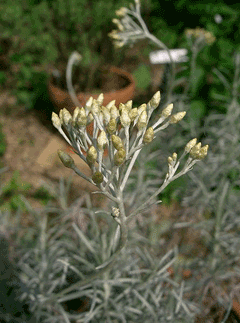 |
|
http://de.wikipedia.org/wiki/Benutzer:Ericsteinert |
 |
| http://commons.wikimedia.org/wiki/User:KENPEI |
Translate this page:
Summary
Physical Characteristics

 Helichrysum italicum is an evergreen Shrub growing to 0.6 m (2ft) by 1 m (3ft 3in).
Helichrysum italicum is an evergreen Shrub growing to 0.6 m (2ft) by 1 m (3ft 3in).
See above for USDA hardiness. It is hardy to UK zone 8 and is not frost tender. It is in leaf all year, in flower from July to August. The species is hermaphrodite (has both male and female organs) and is pollinated by Insects.
Suitable for: light (sandy) and medium (loamy) soils and prefers well-drained soil. Suitable pH: mildly acid, neutral and basic (mildly alkaline) soils. It cannot grow in the shade. It prefers dry or moist soil and can tolerate drought. The plant can tolerates strong winds but not maritime exposure.
UK Hardiness Map
US Hardiness Map
Synonyms
H. angustifolium. (Lam.)DC.
Plant Habitats
Woodland Garden Sunny Edge; Hedge;
Edible Uses
Edible Parts:
Edible Uses: Condiment Tea
Leaves - used as a flavouring in salads and cooked foods[183, 238, 244]. They have a slight flavour of curry, though they do not impart this very well to other foods[K]. An essential oil (from the leaves?) is used as a flavouring to enhance fruit flavours in sweets, ice cream, baked goods, soft drinks and chewing gum[183]. A tea is made from the flower heads[183].
References More on Edible Uses
Medicinal Uses
Plants For A Future can not take any responsibility for any adverse effects from the use of plants. Always seek advice from a professional before using a plant medicinally.
None known
References More on Medicinal Uses
The Bookshop: Edible Plant Books
Our Latest books on Perennial Plants For Food Forests and Permaculture Gardens in paperback or digital formats.

Edible Tropical Plants
Food Forest Plants for Hotter Conditions: 250+ Plants For Tropical Food Forests & Permaculture Gardens.
More

Edible Temperate Plants
Plants for Your Food Forest: 500 Plants for Temperate Food Forests & Permaculture Gardens.
More

More Books
PFAF have eight books available in paperback and digital formats. Browse the shop for more information.
Shop Now
Other Uses
Hedge Hedge
Plants can be grown as a low hedge, the subspecies H. italicum serotinum(Boiss.)P.Fourn. is normally used[29]. It responds well to trimming.
Special Uses
Hedge Hedge Scented Plants
References More on Other Uses
Cultivation details
Requires a light well-drained soil in a sunny sheltered position[1, 200]. Intolerant of excessive moisture[1]. Established plants are drought resistant[190]. Plants have proved to be fairly wind tolerant in an exposed site in Cornwall[K]. This species is not hardy in the colder areas of the country, it tolerates temperatures down to about -10°c[200]. Plants can be pruned back to the old wood in spring in order to maintain the shape of the plant and promote lots of new growth[238]. The whole plant smells of curry, especially after rain[238]. The flowering stems are often dried and used as 'everlasting flowers'[238]. Members of this genus are rarely if ever troubled by browsing deer[233].
References Carbon Farming Information and Carbon Sequestration Information
Temperature Converter
Type a value in the Celsius field to convert the value to Fahrenheit:
Fahrenheit:
The PFAF Bookshop
Plants For A Future have a number of books available in paperback and digital form. Book titles include Edible Plants, Edible Perennials, Edible Trees,Edible Shrubs, Woodland Gardening, and Temperate Food Forest Plants. Our new book is Food Forest Plants For Hotter Conditions (Tropical and Sub-Tropical).
Shop Now
Plant Propagation
Seed - sow February/March in a greenhouse. The seed usually germinates in 2 - 3 weeks at 20°c. When they are large enough to handle, prick the seedlings out into individual pots and grow them on in the greenhouse for at least their first winter. Plant them out into their permanent positions in late spring or early summer, after the last expected frosts. Cuttings of half-ripe wood, 5cm with a heel, June/July in a frame. Roots in 4 weeks. Good percentage[78].
Other Names
If available other names are mentioned here
Native Range
TEMPERATE ASIA: Cyprus EUROPE: Bosnia and Herzegovina, Greece (incl. Crete), Croatia, Italy (incl. Sardinia, Sicily), Montenegro, Slovenia, Spain (incl. Baleares), France (incl. Corsica), Portugal AFRICA: Algeria (north), Morocco, Tunisia
Weed Potential
Right plant wrong place. We are currently updating this section.
Please note that a plant may be invasive in one area but may not in your area so it's worth checking.
Conservation Status
IUCN Red List of Threatened Plants Status :

Growth: S = slow M = medium F = fast. Soil: L = light (sandy) M = medium H = heavy (clay). pH: A = acid N = neutral B = basic (alkaline). Shade: F = full shade S = semi-shade N = no shade. Moisture: D = dry M = Moist We = wet Wa = water.
Now available:
Food Forest Plants for Mediterranean Conditions
350+ Perennial Plants For Mediterranean and Drier Food Forests and Permaculture Gardens.
[Paperback and eBook]
This is the third in Plants For A Future's series of plant guides for food forests tailored to
specific climate zones. Following volumes on temperate and tropical ecosystems, this book focuses
on species suited to Mediterranean conditions—regions with hot, dry summers and cool, wet winters,
often facing the added challenge of climate change.
Read More
Expert comment
Author
(Roth.)G.Don.
Botanical References
50200
Links / References
For a list of references used on this page please go here
Readers comment